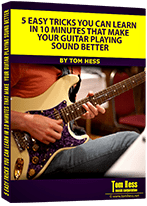Songwriting - Part 5
by Tom Hess
Learn In 10 Minutes

EMAIL TO GET ACCESS
By submitting your info, you agree to send it to Tom Hess Music Corporation who will process and use it according to their privacy policy.
Orchestration: (excerpt from a lesson on Orchestration)
Orchestration is the way timbre is used in musical contexts (songs/compositions). If you have a melody, a bass line and some chords, you can play all of these on a single piano or solo guitar (sometimes). But you can also arrange (orchestrate) these elements (the melody, bass line and chords) for 2 or more instruments. Making the decisions about which instruments will play what notes is the process of orchestrating.
Learn In 10 Minutes

EMAIL TO GET ACCESS
By submitting your info, you agree to send it to Tom Hess Music Corporation who will process and use it according to their privacy policy.
When using multiple instruments, consider how many different ways you may arrange the placement of each instrument in the pitch range spectrum.
[Pitch range spectrum? What is that?... It is the range of all possible notes from very low notes to very high notes and everything in between.]
It is obvious that bass instruments such as, bass guitar, double bass, tubas, contrabassoons, etc. play the lowest notes (the bass notes) in the vast majority of musical contexts that use these instruments. Composers use these instruments in the bass because:
- These instruments can easily play the very low (bass) notes in the pitch range spectrum.
- The tone color quality (the sound) is excellent in their low pitch range.
Because these instruments do play and sound well in low pitch ranges, it is often overlooked that these same instruments can sound great in the tenor range (the pitch range just above the bass range – for example the lowest several notes on a 6 string guitar are in the tenor range). In a typical song (pop, rock, metal, country, blues or jazz) the bass instruments are virtually always playing the lowest sounding notes (the bass notes). Classical music composers of the 19th, 20th and 21st centuries frequently experimented with the role of traditional bass instruments, sometimes placing those instruments higher than (or equal with) tenor or even alto range instruments. This is called “voice crossing” or “crossing voices”. It is generally done as a special effect in the music to bring out contrast in the role and sound of the orchestration.
 Become An Expressive Songwriter
Become An Expressive Songwriter Learn how to develop much better
self-expression as a songwriter.
 How To Record Studio Guitar Parts
How To Record Studio Guitar PartsDiscover the secrets to recording
better quality studio guitar parts.
 Advanced Songwriting Techniques
Advanced Songwriting TechniquesLearn how to create better songs
with this often overlooked element.
Voice crossing involving bass instruments is not common in most non classical music, but why?
- Is it because songwriters around the world thought this whole process through and made an informed artistic decision concluding that crossing the bass instruments above other instruments was a bad idea?
- Did they read it somewhere or conduct a bunch of musical experiments to test the level of value regarding voice crossing?
- Have they studied orchestration either formally or at least informally?
No, in general, non classical music orchestration has been limited to the basics of instrumentation (the common pitch range of instruments) because bass notes are natural for bass instruments, and because that is the way it has traditionally been done. And yes, the usual way of doing things works just fine, that system is not broken, so why fix it? Crossing voices with the bass is not “fixing” anything, it’s simply another useful tool when used in the right places (and when not overused!) It is a cool sound to use in some situations and many bass players love to play high parts but rarely get a chance to in songs.
When you listen to music, notice how infrequently this technique is used, but when you do hear it, analyze how and where it’s used. If you are looking for it, it is pretty easy to hear.
Experiment with voice crossing the next time you write music. If it does not sound good the first time you try it, don’t give up on the concept if it doesn’t improve the sound of your song. Voice crossing does not work in all musical situations. For example, you are more likely to hear it used in instrumental sections (intros, interludes and transitions for example) or a vocal bridge section. Verses and choruses are less likely to contain voice crossing involving the bass instruments. This is because vocal melodies are generally more important than bass lines and crossing voices with the bass will distract one’s ear from the vocal melody. Composers generally want important vocal lines to be clear and without much conflict for the listener’s attention. But don’t let this stop you. Experiment with each section of your song to see if it works for you.
There are 2 main approaches to bass line voice crossing:
- Take your existing bass line and play it 1, 2 or 3 octaves higher than usual. This will usually bring the bass line above the next lowest instrument. This will result in a new bass line because since the original bass line is now “above” something else, the “something else” will become the new bass line (even if it is not being played by a bass instrument)
- Trade parts with another instrument where the bass plays higher than the next lowest instrument. This will result in the bass line staying the same (as far as the actual notes go), but will now be played by another instrument instead of the traditional bass instrument. This is easier to do with a 7 string guitar or piano/keyboard for example.
If you liked this article, you might find the following articles helpful:

